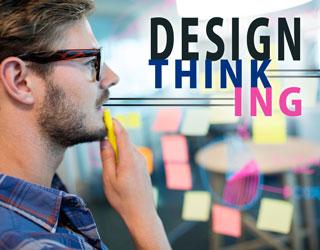
As companies seek more authentic, and meaningful relationships with their customers and employees — while also fostering better communication at all levels — design professionals find themselves in a key position to help bridge the gap. Heck, according to Inc., Designers Are the Next Generation of CEOs. Why? Well, because Designers are at the heart empathy dealers.
In fact, if you spend enough time in design circles you’ll hear the word “empathy” quite frequently, as it’s possibly the most foundational portion of what we do. When you consider that the majority of our work is with someone else’s voice in mind and intended for someone else’s consideration, you’ll realize empathy plays a major part. However, how do you get those who are not designers and not used to working from such abstract starting points, to use those skills to solve problems large or small… without ego, bias, or preconception?
Enter Design Thinking:
For some time now, companies such as IBM, IDEO, and SAP have sought to create a framework that answers the above question; the framework that is called Design Thinking. At its core, Design Thinking works to use multi-disciplinary teams to solve complex problems with a human-centered approach.
It brings together concepts that you may expect to hear talked about in a UX Design course as opposed to board rooms, such as: empathy & journey mapping, storyboarding, and even rapid prototyping. However, if we think about it, whether you’re planning a new product offering, working to understand your teammates better, solving organizational roadblocks, or prioritizing what’s most important for your customer, it all boils down to how humans behave, react, and perceive in these scenarios.
By utilizing rapid brainstorming exercises, diverse groups, constant perception checking, and serial collaboration, design thinking brings empathy to the forefront, giving non-designers a creative toolkit for effective problem solving, while also ensuring that all voices are at the table to ensure the most effective solution.
Design Thinking in Practice:
Over the past year-plus, as part of my service on the board of AIGA Baltimore, I’ve had the fortune to learn, hone, and practice my facilitation skills alongside a number of brilliant design thinkers like IBM (a national partner of AIGA) and learn the methods and techniques used to engage and facilitate design thinking workshops.
Recently, I brought the knowledge I’ve gained into Unleashed’ offices and led my teammates through a rapid brainstorming exercise focused toward how we might implement these tools to solve the web design needs of our users and clients. The foundation of any design thinking engagement is an understanding of the user.
As designers, before we can effectively create a visual (or non-visual) solution, we must first understand the who, what, and why we are working toward. To this end, we built a rough empathy map, that helped us learn about the key users for the mock site we were creating (more on this subject in the second part of this series). Once we had the key user identified, we explored one of my favorite design thinking methodologies, called the Prioritization Grid.
The Prioritization Grid:
One of the reasons I love this exercise, especially as a manner to give a quick sprint example of the usefulness of design thinking, is because it encapsulates the spirit of the process in a rather distilled fashion. When considering a whole host of items, a prioritization grid works to help teams evaluate and prioritize the items by focusing conversations on importance to the user and feasibility to the team. With an emphasis on bringing multidisciplinary teams and stakeholders to the table, this is a perfect way to quickly get ideas from multiple perspectives and to identify gaps that often present themselves when we work in silos.
During the ideation process participants are engaged in a multistep process to take an abstract set of considerations and throughout this begin to create more definition, and consensus, with actionable goals. This process is referred to as: Diverge, Converge, Remix. Combined with Sharebacks, which should take place with stakeholders, individual teams, and even users, these steps will help maintain alignment and focus throughout.
Step 1: Diverge
In the diverge stage, participants are encouraged to silently and rapidly place ideas on the grid based on perceived priority. In the design process, this is a lot like throwing paint at the wall and seeing what sticks. This is a crucial step as the goal is to get the mind to loosen from strict parameters or refinement and focus more on generating ideas – no matter how big, small, outlandish, or silly. At this point, all ideas play a role.
Step 2: Converge
After silently generating ideas, the groups consider all ideas, then discuss their feasibility and usefulness. What’s great here is that as the teams begin to discuss the ideas and the benefit of the multidisciplinary groups begins to show. The echo-chamber opens up and allows different segments of a team to discuss key priorities from their perspective. With this, empathy grows and consensus is found.
Step 3: Remix
Once teams have converged, they move to synthesize the different priorities into related clusters to identify trends and commonalities throughout. Even though we had a diverse team and ideas may have been specific to how that team member approaches the problem, commonalities emerge. In this stage, we find that even in these seemingly vast differences, there are similarities that brings everyone into alignment and moves them close to find solutions for the user in a unified manner. Finally, teams adjusted the axis to find areas of low vs. high priority and/or feasibility and revealed actionable tasks based on practical means and general consensus.
Conclusion
As we wrapped up our mini-session, the biggest benefit came as the different groups found ways to ideate potential solutions that many of them said they may not have thought of on their own. I think my fellow design thinking facilitator and AIGA Central PA chapter President, Bri Picarri said it best:
"By reimagining how people approach tasks, regardless of the level of complexity, requires deep empathy and understanding. Design thinking helps us reconsider a challenge, put ourselves in the shoes of the people who are impacted by our solutions and then explore a diverse range of solutions.” - Shake and Shift
By bringing these and many more design thinking practices into the doors of Unleashed, we’re putting the user first and finding innovative ways to solve problems. If you are interested in learning more about design thinking or would like to consider how facilitation can help you overcome organizational roadblocks within your practice, contact us to continue the discussion. In the meantime, stay tuned as I will be sharing more examples of our explorations in human-centered design in part 2.


